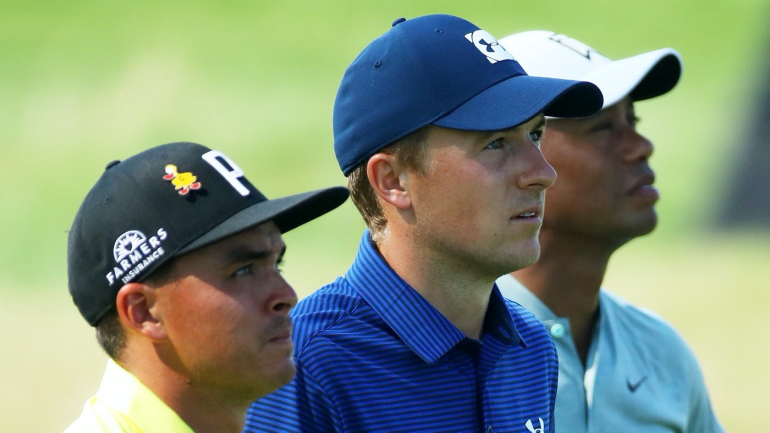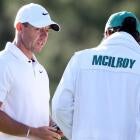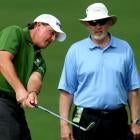
So often the very best and most humorous parts of golf are hidden from the broader public eye. Ken Duke's third round in front of no fans at the Players Championship (he started on the back nine) five years ago comes to mind. Then there's the entire 2019 Presidents Cup, which ended in the middle of the night here in the United States. Rarely does the truly absurd match up with mainstream, primetime, "everybody on the planet is watching this right now" viewership. That's why Tuesday's news that an annual $40 million purse for 10 golfers on the PGA Tour was implemented four months ago without anybody knowing about it is both incredible and also apropos for this sport.
The timing is fortuitous. With the COVID-19 pandemic beginning to dissipate and plumes of Premier Golf League smoke starting to rise once again (along with some other big sports news this week, which we will get to below), the Tour had every reason for this to be the week this news came out. The gist of the massive reward from the PGA Tour, dubbed the Player Impact Program, is this: the 10 most popular players in a given year will split $40 million.
The natural follow-up is, "Wait, why is this based on popularity and not performance?" Well, in a world where hundreds of millions are already doled out for performance, money is not guaranteed to anyone except the Tour itself. Plus, another league is promising more financial stability for the biggest stars in the game (who also generate the most money by bringing in the most fans both in-person and on television), so this was the natural next step.
The details of the report will leave you incredulous. Golfers will be evaluated by Q ratings and social indexes. It reads like a scene from Silicon Valley if there was an episode of Silicon Valley parodying a modern sports league. It reads like an algorithm made up the algorithm that will be determined to distribute nearly as much money from this pot as all four major championships combined.
So I obviously have some thoughts on all of this. Here are seven of them on the implementation of a $40 million fund that seemingly encompasses everything except for the only thing the sport has ever been about.
1. Tiger deserves all $40 million
If the purpose of the Player Impact Program is to reward golfers who have generated revenue for the league as a whole, then Woods' name should auto-populate the top 10 spots for the first five years. That's a $200 million starting position, and it's still too little.
Total combined purses for 1996 season on PGA Tour (year Tiger Woods turned professional): $65.9M
— Justin Ray (@JustinRayGolf) August 20, 2019
Total combined FedExCup bonus payout this week: $70M
2. This was the right move
I agreed with No Laying Up on Tuesday that this is an easy thing to mock -- because anytime you get SEO scientists involved with a sport that was originally predicated on whether the sheep would clear the field, mockery is going to flow. However, I also agreed with them that this was the right move for the Tour. It was actually the only move for the Tour, and probably one that is several years behind where it should have been. The Tour's hand has been forced in a lot of different ways over the last year, and this was a reasonable (and possibly even somewhat cheap) outcome.
3. It's also going to be a mess
Anytime language like "calibrates the value of the engagement a player drives across social and digital channels and the frequency with which a player generates coverage across a range of media platforms" is used to distribute money within any organization, there is going to some manipulation of the system. It seems unlikely that this manipulation will severely affect the intent of the program itself, but there will be some truly incredible moments over the next few years.
4. Response to ESL, not PGL
There was a lot of chatter this week about the Premier Golf League and about how this was another bucket of water on those fading embers. That might be true -- it's probably true -- but because of the timing of this, it actually felt more related to what's going on with soccer's European Super League fissure. If you missed it, the top clubs in Europe tried to break away to form a 20-team super league. It did not go well. To oversimplify it, the clubs probably overplayed their hand instead of just leveraging their position for more resources from their current leagues as well as UEFA and FIFA. This news of the Player Impact Program was the Tour's way of getting out in front of the top players leaving to form their own super league in golf. There are a thousand parallels here, but the best golfers are also the smartest ones, and they will see both how the Tour responded and how badly the European Super League has gone for Manchester United, AC Milan, Arsenal and other European clubs.
5. Meritocracy sounds great
I think golf fans have always believed that this sport is the purest form of meritocracy in the world. The implementation of this program is simply the disclosure that while it might still contain more tenets of meritocracy than Major League Baseball or the NBA, it is still very much a free-market industry that is predicated on six or eight people. The Player Impact Program is the manifestation of that reality.
The problem here -- if there is one -- is mostly a problem of comprehension. Think of golfers like clubs or franchises in another sport. What if the Lakers were guaranteed $0 in revenue by the NBA every year? That's how it works for Rory McIlroy, which is absolutely insane, because if you take the Lakers out of the NBA (or Rory out of the PGA Tour), no matter how they are performing, revenue for the league as a whole goes down over time.
The Tour has been (probably unintentionally) taking advantage of the fact that its "franchises" are just individuals who maybe did not think of themselves as revenue-generating entities. However, the power in golf rests not with the PGA Tour but with the Jordan Spieths and Justin Thomases of the world just as it rests with the Lakers, Knicks and Heat in the NBA. The PGL shined a light on that, and now there's a $40 million purse to prove it.
6. This is how business works
I've seen some reaction like this from current or former players like Mark Calcavecchia below. What Calc is proposing is great in an ideal world. Who wouldn't love to infuse any number of youth programs or developmental tours with loads of cash? But the world of business in a country obsessed with capitalism is far from ideal. The entire structure is disproportionately weighted toward the very top, which is both seemingly unfair but also a harsh reality that many would argue keeps the entire system moving.
Utterly ridiculous! How bout taking that 40 mil and give 20 mil to the @KornFerryTour and the other 20 mil to help grow the game. https://t.co/q9vYvkkojj
— Mark Calcavecchia (@MarkCalc) April 21, 2021
7. The top 10 is the top 10
The easy (and maybe lazy) joke is about how Rickie Fowler -- who is not ranked in the top 100 in the world as of right now -- is going to make more money than most of the top 25 players in the world in a given year. This is actually probably true, but Fowler is also the exception to the rule and not the rule itself. You can quibble with how the algorithm works or what the final rankings are, but did you see what they would have looked like based on the 2019 year? According to Golfweek, the money-earners would have been Tiger Woods, Brooks Koepka, Rory McIlroy, Phil Mickelson, Fowler, Justin Rose, Adam Scott, Jordan Spieth, Dustin Johnson, Justin Thomas.
Those are more or less the 10 guys who should be receiving the money. They are the players who matter as it relates to actual revenue; the ones who bring in the masses who watch the golf, which is why the Tour gets to sign $100 million-dollar deals with TV networks and sponsors like FedEx.
Essential personnel is a term that was tossed around a lot last year. For certain tournaments it meant up to hundreds of individuals involved in hosting and propping up the traveling circus that is the PGA Tour. It's a kind term that is both true in the broad sense but untrue when applied specifically. There are always replacements, except at the top. The cold reality in professional golf that was highlighted this week by the Player Impact Program is that essential personnel is essentially 10 golfers -- the ones who generate (and make) all the money.
![[object Object] Logo](https://sportshub.cbsistatic.com/i/2020/04/22/e9ceb731-8b3f-4c60-98fe-090ab66a2997/screen-shot-2020-04-22-at-11-04-56-am.png)


















